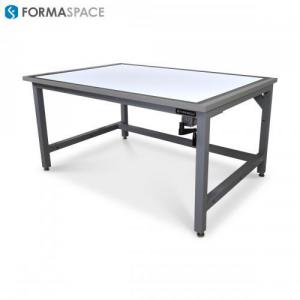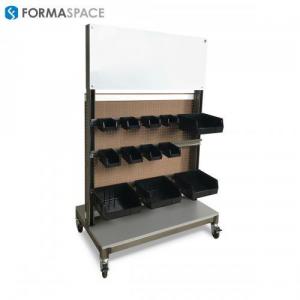Best Practices for K-12 Library to Makerspace Transformations
Are you looking to improve the academic achievement of your K-12 STEM education programs?
AUSTIN, TEXAS, USA, November 25, 2019 /EINPresswire.com/ -- Leading educators are turning to Makerspaces to improve learning outcomes in STEM (Science, Technology, Engineering, and Math) programs.Why? Makerspaces help encourage self-discovery, independent experimentation, and hands-on problem solving among students.
And libraries play a special role in the adoption of Makerspaces, particularly in higher education. According to a recent American Society for Engineering Education (ASEE) survey, libraries are the most common host location for Makerspaces on college and university campuses.
Why libraries? There are several factors at work. First, the traditional role of libraries is in transition, with many hardcopy reference books and periodicals being removed in favor of online resources, which frees up valuable space for other uses. Second, libraries have longstanding expertise in acquiring and managing assets and sharing them equitably with their community.
Here are just a few of the many types of projects K-12 students can pursue in a Makerspace:
Makerspaces offer K-12 students an opportunity to create useful, aesthetic objects driven by their own unique imagination. Younger students can, for example, build 3D objects from soft, color modeling clay (which hardens in a toaster oven) while advanced secondary students can tackle projects ranging from furniture design to using 3D CAD computer software and printing out 3D models.
Makerspace Learning Skills at Work: Problem-solving, sketching, design visualization and conceptualization, sculpting, graphic design, industrial/product design, 3D scanning, 3D CAD design, 3D printing, CNC machining, woodworking, model making, plastic, and metalworking.
Makerspace Learning Skills at Work: Storytelling, storyboarding, scriptwriting, green screen cinematography, video and film editing, presentation communication skills, interactive AR/VR game authoring and programming.
Many of today’s students are motivated to learn about fashion clothing design, quilting, and other textile-based applications. Print technology, whether paper-based lithography or textile graphics, can also engage students while teaching them important design and visualization skills. Taken together, these skills can be applied to future careers, from garment manufacturing to printed circuit design, to advances in wearable technologies.
Makerspace Learning Skills at Work: Sketching and visualization skills, graphic design, print technology, laser cutting, quilting and sewing skills, fashion clothing and accessories design, textile design and technology, inflatable and pneumatic design, and upholstery design.
New low-cost electronic devices, such as the Arduino, Lego Mindstorms, Raspberry Pi, were designed with teaching students in mind. Makerspaces kitted out for experimentation in electronics can help K-12 students develop valuable skills in programming electronic devices, as well as integrating them into Internet-capable devices (Internet of Things), from fighting robots to wearable devices.
Makerspace Learning Skills at Work: Computer programming, problem-solving, electronics integration, circuit design and logic programming (incl. Arduino, Lego Mindstorms, Raspberry Pi), and custom electronics prototyping (soldering, breadboards, etc).
Ready to get started?
Great. Let’s start with some of the key foundational principles that will help make your Makerspace project successful.
1. Safety Is A Primary Design Consideration
Most accidents are preventable — in retrospect. Careful design planning can help you avoid many common types of accidents entirely. For example, much of the equipment in Makerspaces can be considered dangerous if precautions, such as Personal Protective Equipment (PPE) are not taken.
2. Durability Means Longer Service Life
You want to make your investment dollars go further, longer. Makerspace facilities can see extra-heavy-duty use compared to a normal classroom or office environments. That’s why it’s important to choose industrial strength products, such as Formaspace furniture. We build our furniture out of heavy-duty steel then powder coat it for years of service.
3. Flexibility Helps Future Proof Your Investment
Changing requirements are a headache for facility planners and campus architects. But what if your wall systems and furniture installations were easy to update, upgrade, and reconfigure — with simple hand tools.
4. Ergonomics Ensure Health And Wellbeing Of Teachers And Students
As a major American manufacturer of educational furniture for classroom laboratories, libraries, conference rooms, cafeterias, art studio spaces, makerspaces, and more, Formaspace knows that growing students come in different sizes.
5. Partner With A GSA Schedule Suppliers That Can Meet Your Needs
Finally, it’s important to partner with an American furniture manufacturing company that has experience in the education market. Formaspace is a GSA Schedule Supplier with more than 350 college and university clients, including most of the Ivy League institutions, plus countless primary and secondary customers.
Read more ... https://formaspace.com/articles/makerspace/k12-library-to-makerspace-transformations/?utm_source=einpresswire&utm_medium=content&utm_campaign=article-112019
Mehmet Atesoglu
Formaspace
22792792
email us here
ALA 2016: Makerspace Implementation
Legal Disclaimer:
EIN Presswire provides this news content "as is" without warranty of any kind. We do not accept any responsibility or liability for the accuracy, content, images, videos, licenses, completeness, legality, or reliability of the information contained in this article. If you have any complaints or copyright issues related to this article, kindly contact the author above.





